
Macroglossum bombylans, the humble hummingbird hawkmoth, is a moth of the family Sphingidae. It is known from Nepal through China to Taiwan, Korea and Japan, with one record from the Russian Far East. It is also found in northern Thailand, northern Vietnam and the Philippines.

Macroglossum pyrrhosticta, the maile pilau hornworm or burnt-spot hummingbird hawkmoth, is a hawk moth of the family Sphingidae. The species was first described by Arthur Gardiner Butler in 1875.
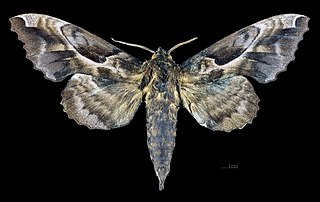
Phyllosphingia is a monotypic moth genus in the family Sphingidae erected by Charles Swinhoe in 1897. Its only species, Phyllosphingia dissimilis, the buff-leaf hawkmoth, was described by Otto Vasilievich Bremer in 1861.
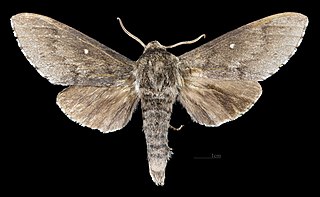
Sphingulus is a genus of moths in the family Sphingidae, containing only one species, Sphingulus mus, the murine hawkmoth.

Clanis bilineata, the two-lined velvet hawkmoth, is a moth of the family Sphingidae first described by Francis Walker in 1866.
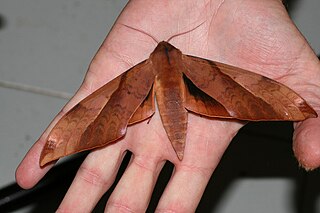
Clanis undulosa, the wavy velvet hawkmoth, is a moth of the family Sphingidae first described by Frederic Moore in 1879. The nominate subspecies is found in the southern Russian Far East, the Korean Peninsula and north-eastern China, as far as south and west as Shaanxi and Hebei. South from Sichuan (Baoxing), Hubei, Jiangxi (Guling) and Zhejiang, it is replaced by ssp. gigantea, which ranges west to Nepal and south, through Thailand and Vietnam, to Peninsular Malaysia.
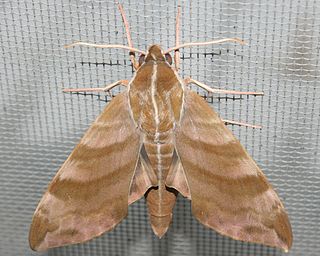
Ampelophaga rubiginosa is a moth of the family Sphingidae. It was described by Otto Vasilievich Bremer and William (Vasilii) Grey in 1853. It is found from north-eastern Afghanistan, east around the southern margin of the Himalaya to Yunnan, then throughout China to the Russian Far East, the Korean Peninsula and Japan. It is also found south through Thailand and Vietnam to Sumatra and Peninsular Malaysia.

Hemaris ducalis, the Pamir bee hawkmoth, is a moth of the family Sphingidae. It is known from the mountains of south-western Xinjiang in China, the western Tian Shan, southern and eastern Kazakhstan up to the Altai Mountains, western Mongolia, southern Uzbekistan, Kyrgyzstan, Tajikistan, northern Afghanistan and Pakistan.

Hemaris ottonis is a moth of the family Sphingidae. It is known from the Russian Far East, north-eastern China and the Korean Peninsula.
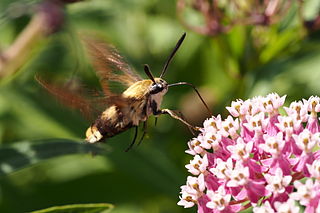
Hemaris radians is a moth of the family Sphingidae. It is known from southern Siberia, Mongolia, the southern Russian Far East, north-eastern and central-eastern China, the Korean Peninsula and Japan.
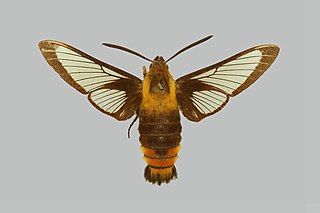
Hemaris staudingeri is a moth of the family Sphingidae. It is found from eastern and central China north to the southern part of the Russian Far East.

Hemaris alaiana, the Alai bee hawkmoth, is a moth of the family Sphingidae. The species was first described by Walter Rothschild and Karl Jordan in 1903. It is known from the Alayskiy Khrebet, Tian Shan, Dzungarian Alatau, Saur and Altai mountains, from Tajikistan and eastern Kazakhstan to western Mongolia. The habitat consists of montane meadows and woodland glades rich in flowers, generally from 1,400 to 2,200 meters altitude.
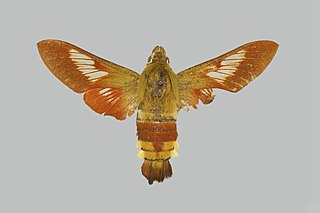
Hemaris dentata, the Anatolian bee hawkmoth, is a moth of the family Sphingidae. The species was first described by Otto Staudinger in 1887. It is known from southern Turkey as far west as the Taurus Mountains.
Hemaris syra, the broad-bordered bee hawkmoth, is a moth of the family Sphingidae. The species was first described by Franz Daniel in 1939. It is known from southern and eastern Turkey, the western Zagros Mountains and northern Alborz Mountains of Iran, the Kopet Dag mountains of Turkmenistan, western Jordan, and northern Israel. The habitat consists of open remnants of former woodland, especially where Lonicera grows through and over low shrubs. It occurs at around 1,000 meters altitude in southern Turkey and from 1500 to 1600 meters in northern Israel.

Hemaris saundersii, or Saunders' bee hawkmoth, is a moth of the family Sphingidae. The species was first described by Francis Walker in 1856. It is found from southern Kashmir, northern Pakistan, northern India and north-eastern Afghanistan, eastwards along the Himalayan foothills of India to Bangladesh and northern Myanmar. The habitat consists of scrub-jungle at 1,800 to 3,000 metres altitude.

Meganoton analis, the grey double-bristled hawkmoth, is a moth of the family Sphingidae. It is known from India, Nepal, southern and eastern China, northern Thailand, northern Vietnam, Peninsular Malaysia, Indonesia, Taiwan, the southern part of the Russian Far East, South Korea and Japan.

Mimas christophi, the alder hawkmoth, is a species of moth of the family Sphingidae.

Marumba maackii, the Manchurian hawkmoth, is a species of moth of the family Sphingidae. It is known from the Russian Far East, north-eastern China, North Korea, South Korea and Hokkaido in northern Japan.
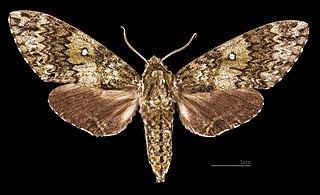
Dolbina tancrei is a species of moth of the family Sphingidae.

Diervilla lonicera, commonly referred to as northern bush honeysuckle, low bush honeysuckle, dwarf bush honeysuckle, or yellow-flowered upright honeysuckle, is a deciduous shrub native to the northeastern United States and Canada. Its specific epithet, lonicera refers to its similarity in appearance to the true honeysuckles, genus Lonicera. It attracts bumblebees and is an important source of nectar for them.




















